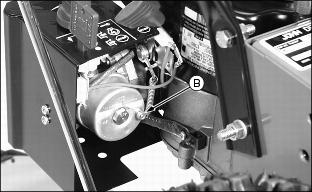Introduction
Safety Signs
Controls
Operating
Service Machine Safely
Service
Troubleshooting
Storing Machine
Preparing Snowblower for Storage
Removing Snowblower From Storage
Assembly
Specifications
Warranty
John Deere Quality Statement
CopyrightŠ Deere & Company

Storing Machine
Storing Safety
Preparing Snowblower for Storage
1. Remove any snow, ice or slush from exterior of engine.
1. Change engine oil and filter. Do when engine is warm.
2. Clean debris from engine cylinder fins.
3. Repair any worn or damaged parts. Replace parts if necessary. Tighten loose hardware.
4. Paint scratched or chipped metal surfaces to prevent rust.
5. Apply wax to metal and plastic surfaces of machine.
6. Apply light coat of engine oil to pivot and wear points to prevent rust.
7. Make sure tires are properly inflated.
Preparing Engine For Storage
NOTE: Properly preparing your snowblower engine for storage will make it easier to start the following season. Engine storage procedure should be used if snowblower is stored for longer than 60 days.
1. Park snowblower in a well-ventilated area.
2. Turn fuel shut-off valve (A) to OFF.
4. Drain any excess fuel from carburetor.
ˇ Hold paper towel under carburetor to catch any remaining fuel. Dispose of paper towel in appropriate manner.
ˇ Push carburetor drain screw (B) until fuel stops draining from carburetor.
ˇ Release carburetor drain screw.
IMPORTANT: Avoid damage! Be sure fuel is fresh when adding fuel stabilizer. Fuel stabilizers are ineffective when added to fuels that are more than 30 days old. |
5. Add stabilizer to fuel system.
ˇ Mix fresh fuel and fuel stabilizer in separate container. Follow stabilizer instructions for mixing.
NOTE: Filling the fuel tank reduces the amount of air in the fuel tank and helps reduce deterioration of fuel.
ˇ Fill fuel tank with stabilized fuel.
6. Remove spark plugs. Put 30 mL (1 oz.) of clean engine oil in cylinders.
7. Install spark plugs, but DO NOT connect spark plug wires.
8. Crank the engine for approximately five seconds to allow oil to be distributed.
9. Store the snowblower in a dry, protected place. If snowblower is stored outside, put a waterproof cover over it.
Removing Snowblower From Storage
1. Inflate tires to: 110 kPa (15 psi) maximum pressure.
4. Remove spark plug. Cover plug hole with rag. Remove oil from cylinder:
ˇ Pull starter handle several full strokes OR
ˇ Use electric starter to crank engine several seconds.
5. Check spark plug gap. Install plug. Connect wire.
6. Lubricate chain and pivot points.
7. Lubricate internal drive. (See Lubricating Internal Drive in the SERVICE section.)
10. Covers, guards, and shields must be in place.
11. Adjustments must be correct.
12. Warm engine several minutes before you operate snowblower.


